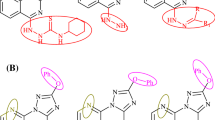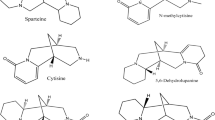Abstract
The hydroxyl radical (•OH) scavenging and ferrous ion chelating activities of four isoquinoline alkaloids isolated from Coptis chinensis Franch were studied for the identification of their structural characteristics to scavenge •OH. The •OH was generated via Fe(II)-catalazed Fenton reaction in this study and the reliable measurement of •OH scavenging activities of isoquinoline alkaloids were achieved using electron spin resonance (ESR) spectrometry method. At the 1 mM concentration, berberrubine (85%) showed the strongest •OH scavenging activity and the next were in the decreasing order of coptisine (79%), berberine (23%), and palmatine (22%). The ferrous ion chelating effects of the alkaloids showed similar pattern with their •OH scavenging effects. These results suggest that •OH scavenging effects of the alkaloids were closely related to their ferrous ion chelating activities. In addition, metal chelating functional groups such as hydroxy group at C-9 and methylenedioxy group at C-9 and C-10 were thought to contribute to the •OH scavenging activities of the isoquinoline alkaloids.
Similar content being viewed by others
References
Aruoma, O. I., Characterization of drugs as antioxidant prophylactics. Free Radical Biol. Med., 20, 675–705 (1996).
Decker, E. A. and Welch, B., Role of ferritin as a lipid oxidation catalyst in muscle food. J. Agric. Food Chem., 38, 674–677 (1990).
Duthie, S. J., Ma, A., Ross, M. A., and Collins, A. R., Antioxidant supplementation decreases oxidative DNA damage in human lymphocytes. Cancer Res., 56, 1291–1295 (1996).
Gulcin, I., Antioxidant and antiradical activities of L-carnitine. Life Sci., 78, 803–811 (2006).
Halbsguth, C., Meissner, O., and Haberlein, H., Positive cooperation of protoberberine type 2 alkaloids from Corydalis cava on the GABA(A) binding site. Planta Med., 69, 305–309 (2003).
Halliwell, B., Gutteridge, J. M., and Cross, C. E., Free radicals, antioxidants, and human disease: where are we now? J. Lab. Clin. Med., 119, 598–620 (1992).
Hsieh, T. J, Chia, Y. C., Wu, Y. C., and Chen, C. Y., Chemical constituents from the stems of Mahonia japonica. J. Chin. Chem. Soc., 51, 443–446 (2004).
Huang, D., Ou, B., and Prior, R. L., The chemistry behind antioxidant capacity assays. J. Agric. Food Chem., 53, 1841–1856 (2005).
Leopoldini, M., Russo, N., Chiodo, S., and Toscano, M.,. Iron chelation by the powerful antioxidant flavonoid quercetin. J. Agric. Food Chem., 54, 6343–6351 (2006).
Liu, B., Li, W., Chang, Y., Dong, W., and Ni, L., Extraction of berberine from rhizome of Coptis chinensis Franch using supercritical fluid extraction. J. Pharm. Biomed. Anal., 41, 1056–1060 (2006).
Mandel, S., Amit, T., Reznichenko, L., Weinreb, O., and Youdim, M. B., Green tea catechins as brain-permeable, natural iron chelators-antioxidants for the treatment of neurodegenerative disorders. Mol. Nutr. Food Res., 50, 229–234 (2006).
Qin, Y., Pang, J. Y., Chen, W. H., Cai, Z., and Jiang, Z. H., Synthesis, DNA-binding affinities, and binding mode of berberine dimers. Bioorg. Med. Chem., 14, 25–32 (2006).
Rohn, S. and Kroh, L. W., Electron spin resonance—a spectroscopic method for determining the antioxidative activity. Mol. Nutr. Food Res., 49, 898–907 (2005).
Sarma, L., Devasagayam, T. P., Mohan, H., Mittal, J. P., and Kesavan, P. C., Mechanisms of protection by buthionine sulphoximine against gamma-ray-induced micronuclei in polychromatic erythrocytes of mouse bone marrow. Int. J. Radiat. Biol., 69, 633–643 (1996).
Schinella, G. R., Tournier, H. A., Prieto, J. M., Mordujovich de Buschiazzo, P., and Ríos, J. L., Antioxidant activity of anti-inflammatory plant extracts. Life Sci., 70, 1023–1033 (2002).
Valko, M., Leibfritz, D., Moncol, J., Cronin, M. T., Mazur, M., and Telser, J., Free radicals and antioxidants in normal physiological functions and human disease. Int. J. Biochem. Cell Biol., 39, 44–84 (2007).
Yang, Z. Q., Yang, S. F., Yang, J. Q., Zhou, Q. X., and Li, S. L., Protective effects and mechanism of total coptis alkaloids on a beta 25–35 induced learning and memory dysfunction in rats. Chin. J. Integr. Med., 13, 50–54 (2007).
Yokozawa, T., Satoh, A., Cho, E. J., Kashiwada, Y., and Ikeshiro, Y., Protective role of Coptidis Rhizoma alkaloids against peroxynitrite-induced damage to renal tubular epithelial cells. J. Pharm. Pharmacol., 57, 367–374 (2005).
Yuan, Y. V., Bone, D. E., and Carrington, M. F., Antioxidant activity of dulse (Palmaria palmata) extract evaluated in vitro. Food Chem., 91, 485–494 (2005).
Zhang, H. Y., Yang, D. P., and Tang, G. Y., Multipotent antioxidants: from screening to design. Drug Discov. Today, 11, 749–754 (2006).
Author information
Authors and Affiliations
Corresponding author
Rights and permissions
About this article
Cite this article
Jang, M.H., Kim, H.Y., Kang, K.S. et al. Hydroxyl radical scavenging activities of isoquinoline alkaloids isolated from Coptis chinensis . Arch. Pharm. Res. 32, 341–345 (2009). https://doi.org/10.1007/s12272-009-1305-z
Received:
Revised:
Accepted:
Published:
Issue Date:
DOI: https://doi.org/10.1007/s12272-009-1305-z




